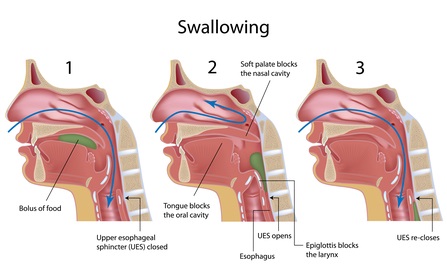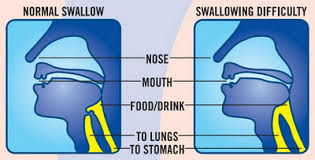Blog
Dysphagia: Causes, Symptoms, & Treatments
What is Dysphagia?
Dysphagia is the medical term for difficulty swallowing, derived from the Greek word “phagein” meaning “to eat.” One in every 17 people will develop a form of dysphagia at some point in their life. It can be caused by the following: stroke/acquired brain injury, spinal cord injury, degenerative diseases, Alzheimer’s disease, cancer, head/neck injury, decayed/missing teeth, and poorly fit dentures. Dysphagia can occur at different stages in the swallowing process:

- 1 Oral Phase – Chewing food and moving food/liquid into the throat
- 2 Pharyngeal Phase – Initiating the swallow reflex via closing the airway while food is squeezed down the throat
- 3 Esophageal Phase – Passing food through the esophagus to the stomach
Aspiration is a symptom of dysphagia that occurs when food, saliva, or liquid enters the trachea below the level of the vocal cords (a.k.a. “goes down the wrong pipe”). A typical reaction to aspiration is a strong cough; however, aspiration can be silent following brain injury. When the individual’s cough is weak or absent (silent), it increases the risk of developing aspiration pneumonia. Other signs of dysphagia include:

- Coughing/throat clearing during or following eating/drinking
- Wet (gurgly) vocal quality during or following eating/drinking
- Extra effort or prolonged time chewing/swallowing
- Food or liquid spilling from the lips or getting stuck in the mouth/throat
- Recurrent pneumonia or chest congestion following meals
- Weight loss and dehydration
Therapeutic intervention for Dysphagia includes diet modifications (e.g. thickened liquids, altered food consistencies) or alterations to food presentation (e.g. feeding tube, nasogastric tube, etc.). Here are general tips for safe eating:
- Sit upright during mealtime and 30-minutes post mealtime
- Minimize distractions (e.g. turn off the TV, hide phone, eliminate background noise/distractions)
- Chew carefully
- Decrease bite and sip size while eating
- Avoid talking when eating/drinking
- Eat slowly
Jessica Eberhardt M.S. CF-SLP TSSLD




